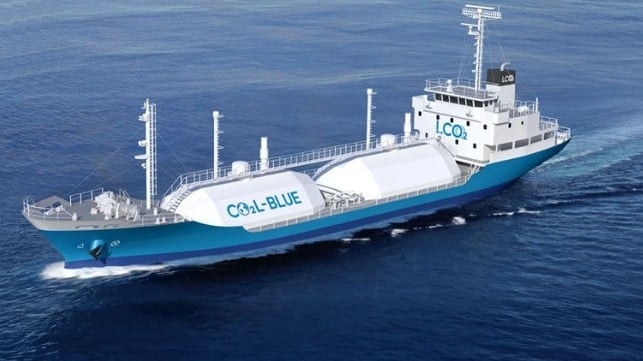Construction Begins in Japan on Demonstration LCO2 Carrier

Construction has begun in Japan on the first demonstration ship for the transport of liquified CO2 as part of a research project for the capture and transport of carbon emissions. The ship is being built by Mitsubishi Shipbuilding at its Shimonoseki Shipyard & Machinery Works in Shimonoseki and is scheduled for delivery before the end of 2023.
The keel laying ceremony took place on October 7, making the next phase of a project launched in 2021 by Japan’s New Energy and Industrial Technology Development Organization (NEDO). The program focuses on research and demonstration projects for carbon capture, utilization, and storage. The vessel will be approximately 236 feet long with a capacity of 1,450 cubic meters.
The project involves a partnership of Japanese companies. The Engineering Advancement Association of Japan (ENAA) research the hull design and developed the liquefied CO2 tank system. ENNA will charter the ship from Sanyu Kisen, and install and operate the LCO2 marine tank system used to conduct the research. Three additional project partners, Kawasaki Kisen Kaisha, Ltd. (“K” LINE), Nippon Gas Line Co., and Ochanomizu University, will be commissioned by ENAA to conduct R&D on the pressure control and stability of the LCO2 transported on the ship, and plan demonstration experiments, as well as develop and demonstrate technologies for safe and low-cost CO2 transport. “K” Line will also carry out a risk assessment on the safety systems of the demonstration test ship and will contribute to the development of an operation manual for the vessel. Mitsui O.S.K. Lines was also involved with earlier R&D as part of the overall carbon capture research effort.
NEDO called for proposals for R&D and demonstration projects as part of an effort to develop appropriate business models to transport CO2 safely and economically. The program is looking for means to safely transport large volumes of CO2 emitted from factories and thermal power plants to areas, where CO2 can either be used or stored at a low cost. The R&D effort is expected to continue o 2026.
The Japanese government is supporting several research projects designed to advance shipping solutions to meet the challenges of decarbonization. A second project built a similar size demonstration vessel as the first to transport large volumes of hydrogen as part of an effort to commercialize hydrogen production and transportation. Launched in 2019, the Suiso Frontier is a 380-foot-long vessel designed to transport super-cooled hydrogen. Built by Kawasaki Heavy Industries, the vessel conducted a demonstration voyage loading hydrogen in Australia and transporting it to Japan.
